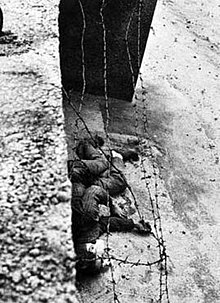Checkpoint Charlie
[2] After the dissolution of the Eastern Bloc and the reunification of Germany, the American guard house at Checkpoint Charlie became a tourist attraction.
[5] The emigrants tended to be young and well educated,[6] including many professionals — engineers, technicians, physicians, teachers, lawyers and skilled workers.
The development of the infrastructure around the checkpoint was largely asymmetrical, reflecting the contrary priorities of East German and Western border authorities.
During its 28-year active life, the infrastructure on the Eastern side was expanded to include not only the wall, watchtower and zig-zag barriers, but a multi-lane shed where cars and their occupants were checked.
A wooden shed used as the guard house was replaced during the 1980s by a larger metal structure, now displayed at the Allied Museum in western Berlin.
[citation needed] Soon after the construction of the Berlin Wall in August 1961, a stand-off occurred between US and Soviet tanks on either side of Checkpoint Charlie.
Discussions between US Attorney General Robert F. Kennedy and Soviet intelligence officer Georgi Bolshakov played a vital role in realizing this tacit agreement.
[15] The Berlin Wall was erected with great speed by the East German government in 1961, but there were initially many means of escape that had not been anticipated.
For example, Checkpoint Charlie was initially blocked only by a gate, and a citizen of the GDR (East Germany) smashed a car through it to escape, so a strong pole was erected.
Western units were deployed in the middle of the night in early September with live armaments and vehicles, in order to enforce the ban.
[citation needed] Developers demolished the last surviving major original Checkpoint Charlie structure, the East German watchtower, in 2000, to make way for offices and shops.
However, the indoor exhibition (entrance fee required) illustrates Berlin's contemporary history with 16 media stations, a movie theatre and original objects and documents.
It is run by the NGO Berliner Forum fuer Geschichte und Gegenwart e.V..[21] Near the location of the guard house is the Haus am Checkpoint Charlie.
The "Mauermuseum - Museum Haus am Checkpoint Charlie" was opened on 14 June 1963[citation needed] in the immediate vicinity of the Berlin Wall.
From October 2004 until July 2005, the Freedom Memorial, consisting of original wall segments and 1,067 commemorative crosses, stood on a leased site.
James Bond (played by Roger Moore) passed through Checkpoint Charlie in the film Octopussy (1983) from West to East.
[26] The song Checkpoint Charlie from Steven Van Zandt's 1984 album Voice of America makes a plea for the wall to be torn down.
At the border crossing from Hyder in Alaska, USA to Stewart in British Columbia, Canada, there is a humorous imitation of the Checkpoint Charlie sign with the inscription "You are leaving the American Sector" in English, French, and German, as well as a sign reading "Eastern Sektor",[27] as Stewart is located east of Hyder.






